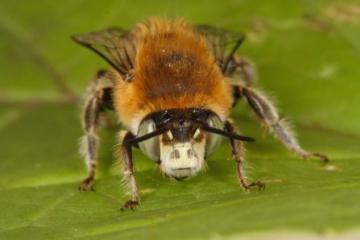Species Account for Anthophora quadrimaculata
Anthophora quadrimaculata (Panzer, 1798)
a solitary bee
Aculeata: Anthophorinae

Reproduction for study and non-profit use permitted, all other rights reserved.
Taxonomic group: bees and wasps (Aculeata) - County data
View time series maps for Anthophora quadrimaculata
member log-on for taxon report
Status: Nb
Essex RDB: Listed
Threat: Regionally Important
Images
upload a new image
Species text
Anthophora quadrimaculata is a very local species which is sometimes common in gardens. Post-1970 information is known for about 30 sites, mostly in Kent, with others sparsely scattered over southern England (Falk, 1991b). It is principally a bee of gardens and suburban waste ground. Occasionally encountered in other habitats such as on coastal cliffs, coastal dunes and heathland. Nesting usually occurs in light soil, including on sandy banks and cliffs, and clay or mortar walls. It can occur in small aggregations. Sunny, south facing situations are favoured. The British pollen sources are unknown but it shows a preference for labiates such as Nepeta and Lamium purpureum in gardens. Other flower visiting records include Ononis, Euphorbia paralias, Echium, Linaria purpurea, Salvia officinalis, Lavandula, Stachys germanica, Ballota nigra, Lamium album and Teucrium scorodonia. Threats include the loss of urban waste ground and other subsidiary habitats to development, agriculture and intensive forestry. Many sites have become unsuitable, either by scrub encroachment and the shading out of nesting sites and forage plants or the loss of flower-richness through factors such as 'tidying up' sites. Management should maintain suitable nesting sites (e.g. earth banks or old walls) in warm and sunny situations and prevent the formation of scrub or coarse vegetation using grazing, burning or cutting as appropriate. Plenty of flowers should be encouraged, especially labiates such as Nepeta and Lamium purpureum. The presence of suitable nesting sites and suitable flowers is likely to depend on some disturbance at many localities, especially on waste ground (Falk, op. cit.). References
Habitats
Recorded management for locations with Anthophora quadrimaculata
Recorded substrate and hydrology for locations with Anthophora quadrimaculata
Why not join the Club, register and add a new species page
Interpretation of distribution maps



















